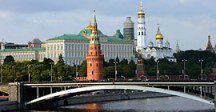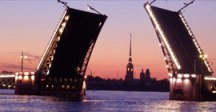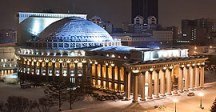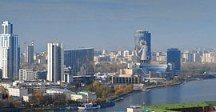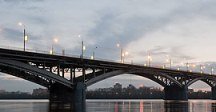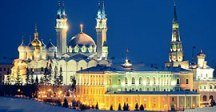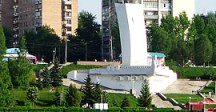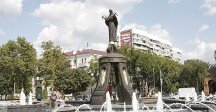Map of Orel
Detailed interactive map of Orel. Map of Orel with streets and numbers of houses. Satellite map of Orel with sights of the city.
The change between the satellite map of Orel and the schematic one is made in the lower left corner of the interactive map.
Orel
Population of the city Orel: 303,696 people (2021)
Date of foundation of the city Orel: September 21, 1566
Orel city phone code: +7 4862
Orel automobile area code: 57
Postal code of the city of Orel: 302000-302999
Orel is a Russian city with a population of just over 300,000 people. Two rivers flow through the city, merging together – the Eagle and the Oka. The very history of the city began in 1566. The eagle has always been known for its fertile lands. It was the nature of the city that attracted writers and landowners here, especially in the 19th century. Therefore, Orel quickly won the title of a literary city, which became the home of such famous writers as Andreev, Prishvin, Turgenev, etc.
Although Orel is a small city, there are plenty of attractions in it. Several houses in the city are particularly interesting. For example, a flat house on Lenin Street or the so-called "Falling House". There are several religious buildings in the city. The most famous of them are the two city monasteries. The first is the Holy Dormition Monastery, founded at the end of the 17th century, and the second is the Vvedensky Monastery built in the 18th century.
What to see in the city Orel
Monument to the Eagle. There is an excellent modern sculpture of a giant eagle on the Forecourt at the roundabout outside the railway station. The braided sculpture is made of straw woven on a wire base, which makes the bird quite realistic.
The Church of Our Lady of Iver on privokzalnaya Street. The first stones of the beautiful Iverskaya Church of Our Lady were laid in 1899 to commemorate the coronation of Emperor Nicholas II. Its main altar was consecrated in 1902, and the side altars in 1903 and 1907, when Emperor Nicholas II himself donated money to complete the construction. The church was built in the Russian style, and its main structure is crowned with nine domes on three levels, a small bell tower is attached to the facade.
The Akhtyr Diocesan Cathedral of the Blessed Virgin Mary on August 5 Street was originally a church and was built in 1775 on the initiative of a local merchant who claimed to have been healed by the icon of the Akhtyr Mother of God. The church was expanded in 1775 and again in 1803. In 1823, its most striking feature was added - a four-tiered bell tower, which was attached to the church through an enclosed vestibule in 1870.
The Resurrection Church on 1st Kurskaya Street was consecrated in 2001 and is located at the Afanasievsky Cemetery, which was founded in 1887 as the cemetery of the Holy Vvedensky Convent. The modern church was built to replace an earlier wooden version that was built in 1895.
The Holy Vvedensky Convent is considered to have been founded in 1686, when the construction of its first church began. In 1843, the monastery burned to the ground, and in 1848 it was restored to its current location.
The Vladimir Rusanov House Museum on Rusanov Street. Vladimir Rusanov was born in 1875 in Orel and became a talented geologist and a famous Arctic explorer. In 1912, he set off from Novaya Zemlya in an attempt to reach the Pacific Ocean via the Northern Sea Route, and was never seen again, although parts of his boat were found in 1937. This museum was opened in 1982 in the house where Rusanov spent his childhood, and it presents materials about his life and work. The museum operates as a branch of the Regional Museum of Local Lore.
Pobedy Pedestrian Boulevard runs from the back of the Orel Region administration building along Saltykov-Shchedrin Street to Leskov Street. At the beginning of the boulevard there is a standard obelisk of the city of Military Glory in memory of the assignment of the status of the city of Military Glory to the Eagle in 2007.
Noble Nest Park. Next to the Nikolai Leskov House Museum at the beginning of Oktyabrskaya Street is a park known as the Noble Nest, which is the Russian name of Roman Turgenev. In the park there is a bust of Turgenev, a gazebo and a house known as the House of Lisa Kalitina.
Monument to Felix Dzerzhinsky at the intersection of Polesskaya Street and Saltykov-Shchedrin Street. Dzerzhinsky is associated with the Eagle, as he was an inmate of the Orel Central Prison from 1915 to 1916.
Monument to the Heroes of the Civil War at the intersection of Turgenev and Brestskaya streets. This Soviet-style monument is dedicated to the heroes of the Russian Civil War and depicts a girl in military uniform standing on top of a high granite pedestal and holding a rifle in the air in one hand and flowers in the other.
Monument to Ivan Bunin. On the Proletarian Mountain there is a monument to the writer and poet Ivan Bunin, who lived in Orel for several years and began his literary career here, working for a local newspaper. In 1933, he was awarded the Nobel Prize in Literature. This monument depicts Bunin in full growth and was opened in 1995.
The Ivan Bunin Museum was opened in 1991 in one of the old mansions of the city. The museum tells in detail about Bunin's work both in Orel and abroad, as well as presents some personal belongings.
Monument to Ivan Turgenev. A monument to the writer Ivan Turgenev is located on the territory of the city park of culture and recreation. Ivan Turgenev was born in Orel in 1818, and his family owned the Spasskoye-Lutovinovo estate near the nearby town of Mtsensk.
The Ivan Turgenev State Literary Museum is one of the oldest literary museums in Russia, founded in 1918 to mark the 100th anniversary of the birth of the great Russian writer in Orel. It is located in a late 19th century mansion and tells in detail about Turgenev's work and life, including his life abroad and his love for French singer Pauline Viardot. Turgenev's personal belongings are also on display at the exhibition.
Mikhail Bakhtin Museum. Mikhail Bakhtin was a Russian philosopher and linguist born in Orel in 1895. In 2005, a museum dedicated to his life and work was opened on the site where the estate of the Bakhtin family once stood and where Bakhtin was born. The museum displays the philosopher's personal belongings, as well as photographs of him and the Eagle of that time.
The Orel Museum of Applied Art was founded in 1957 as the Orel Art Gallery. Now it is located in the former House of Political Education, which was built in 1959. The museum's collection contains more than 4,000 works of art, including paintings, graphic works, sculptures and objects of decorative and applied art, from the 17th century to the present day, including both foreign and Russian works.
The Museum of Orel Writers on Turgenev Street. Seven halls of the museum are dedicated to the life and work of poet Afanasy Fet, playwright and novelist Leonid Andreev, novelist Boris Zaitsev, as well as authors Mikhail Prishvin and Ivan Novikov, all of them were born either in Orel itself or in the Orel province.
The Holy Dormition Monastery was founded on Yamskaya Hill in 1673 after the Epiphany Monastery burned down and it was decided not to rebuild it, but to build a new monastery in a new place. In 1688, the Assumption Church was completed, which was joined by the Trinity Cathedral in 1879.
The Trinity Church was built between 1823 and 1828 at the Trinity Cemetery, which dates back to 1778. The family crypt of the Ermolov family is located in the southern altar of the church. General Alexey Ermolov, the hero of the Patriotic War of 1812 against Napoleon, is buried here with his father and son.
The monument to Vladimir Lenin stands on Lenin Square immediately behind the building of the administration of the Orel region. The statue was originally unveiled in 1949 in Karl Marx Square, replacing an earlier version that was destroyed during the war.
The Orel Offensive Diorama Museum was opened in 1983 on the 40th anniversary of the liberation of Orel and is dedicated to the Orel Offensive Operation of World War II, which is also known as Operation Kutuzov. The most striking feature of the museum is its diorama measuring 9 by 33 meters, which depicts the events of the battle of July 12, 1943.
Monument to Alexei Ermolov. Alexey Ermolov was a Russian general who participated in the Napoleonic War and as commander-in-chief during the Caucasian War. Although he was born and died in Moscow, his family owned an estate near Orel, and he spent a lot of time there in his later life. Ermolov is also buried in the Orel Trinity Church in the family crypt. This four-meter monument depicting Ermolov riding a horse was unveiled in 2012 on the square bearing his name.
The Cathedral of the Archangel Michael is located in the center of Orel, near the banks of the Orlik River. Emperor Alexander I worshipped here in 1823, and in 1826 his body was briefly buried here upon his return to St. Petersburg from Taganrog.
Smolensk Cathedral of the Blessed Virgin Mary. The largest cathedral in Orel is the Cathedral of Our Lady of Smolensk, which was built between 1857 and 1895. In 1908, a 52-meter five-tiered bell tower was added. The cathedral is a four-tiered pink structure with five golden domes.
The Regional Museum of the Orel region on the Living Room street. The museum tells in detail about the history of the region in ancient times, during the Russian Empire, the Russian Revolution, the Second World War and in our time. It also has a department dedicated to the flora and fauna of the Orel region.
The Church of St. John the Baptist was built between 1774 and 1777 on the southwestern outskirts of the city at the Baptist Cemetery, which was opened in 1772. Also in the cemetery is a mass grave of Soviet soldiers who died during the liberation of Orel in 1943.
Arrow of Oka and Orlik. The cape formed by the Orlik River, which flows into the Oka River, is known as Strelka. At the end of the Arrow there is a monument to the 400th anniversary of the city, since it was here that the Orel Fortress was founded in 1566. The monument has the shape of a 27-meter granite pedestal. Next to this monument there is a war memorial dedicated to the liberation of the Eagle, consisting of the personification of Victory and two soldiers.
Transport in Orel
Orlovsky Railway Station is located about 3 km from the city center. You can get to the center from the railway station by bus No. 18 or trolleybuses No. 3 or No. 8. You can also use any minibus that goes to Lenin Square or Turgenev Street.
Popular destinations: Moscow, St. Petersburg, Belgorod, Kursk, Sevastopol, Simferopol, Kislovodsk, Rostov-on-Don, Voronezh, Anapa, Adler, Sochi, Cherepovets, Vorkuta. Popular international destinations include: Kharkiv, Donetsk. Station address: Station Forecourt, 1.
Orel Bus Station is located about 7 km from Lenin Square. From Lenin Square you can take bus No. 18, No. 26 or No. 28 or minibus No. 354. The address of the bus station: Bus Station street, 1.
Buses from Moscow to Orel depart 4 times a day. The duration of the trip is about 6 hours. Buses arrive at the Orel bus station. The most convenient train from St. Petersburg is the St. Petersburg - Sevastopol train. You can get from Orel to Mtsensk by express bus, which departs from the bus station every hour.
Sights of Orel
Noble Nest, Monument to Ivan the Terrible, Holy Dormition Monastery, Peter and Paul Cathedral, L. N. Andreev House Museum, Russian Style Theater, Borisoglebsky Cathedral, Park of Culture and Recreation, Tankers Square, Vvedensky Monastery, Epiphany Cathedral, St. George's Church, Monument to I. A. Bunin, Pokrovskaya Church, Orel Museum of Local Lore, Orel Military Historical Museum, Orel United Literary Museum named after I.S. Turgenev, I. A. Bunin Museum, N.S. Leskov House Museum, Orel State Academic Theater named after I.S. Turgenev, Orel Regional Puppet Theater, Landscape Park Dvoryanskoe nest.
The largest cities in Russia:
2024 © Russia-Karta.ru
